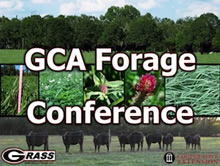2013 GCA Forage Conference
 The 2nd Annual Forage Conference at the Georgia Cattlemen's Convention was held on April 3-4, 2013 at the Georgia National Fairgrounds in Perry, GA. We teamed up with the Georgia Cattlemen's Association to offer a new learning opportunity in combination with the GCA's annual cattlemen's convention.
The 2nd Annual Forage Conference at the Georgia Cattlemen's Convention was held on April 3-4, 2013 at the Georgia National Fairgrounds in Perry, GA. We teamed up with the Georgia Cattlemen's Association to offer a new learning opportunity in combination with the GCA's annual cattlemen's convention.
Program Details
In keeping with this year’s theme of “Making the Best Better,” the program focused on several key areas of management that can make even the best operation better. First, Dr. Dennis Hancock, Extension Forage Specialist at the University of Georgia, began the program with a mini-“hay school,” which covered key steps to making more and better hay. Then, producers had an opportunity to learn more about new insect and pest issues, including an update on the bermudagrass stem maggot. On Wednesday afternoon, Dr. Curt Lacy, Extension Livestock Economist at the University of Georgia, provided an economic outlook for 2012 and covered some of the new drought insurance products that are on the market. Then, Thursday afternoon’s program kicked off with specialists from Auburn University and the University of Florida who talked about the opportunity to renovate and improve tall fescue, bermudagrass, and bahiagrass pastures.
Below is an outline of the presentations that were made, along with some additional resources for each topic. Click the link to access the slidesets in handout form or to access the supplemental links. All linked documents are in a PDF or Excel file format.
- Weed Management in the Hayfield
- Making, Storing, and Feeding Round Bale Silage
- Insect Management in the Hayfield
- Biology and Control of the Green June Beetle
- Management of Fall Armyworm in Pastures and Hayfields
- Management of Imported Fire Ants in Cattle Production Systems
- Fire Ant Quarantine and Hay Transport Guidelines
- Blister Beetles in Alfalfa
- Perennial Grass Insect Control
- Alfalfa Insect Control
- Clover Insect Control
- Cattle Weaning and Feeding Strategies for Traditional and Alternative Markets
- Forage Management Strategies for Reducing Risk
- UGA Basic Balancer DEMO
- UGA Hay, Pasture, and Livestock Production Budgets
- Cow-Calf Budget (North Georgia) - 2013
- Cow-Calf Budget (South Georgia) - 2013
- Hybrid Bermuda Hay - Irrigated, Large Round Rolls
- Hybrid Bermuda Hay - Non-Irrigated, Large Round Rolls
- Stockering Steers on Stockpiled Fescue, Winter Annuals Hay & Supplement without Clover
- Stockering Steers on Stockpiled Fescue, Winter Annuals Hay & Supplement with Clover
- Stockering Lightweight Steers on Temporary Winter Grazing, Hay & Supplement
- Stockering Steers on Temporary Winter Grazing, Hay & Supplement - 500# Steer
- Insurance Options for Forage and Livestock Producers
- Improving and Managing Tall Fescue Pastures
- Incorporating Legumes into Georgia's Forage Systems
- Improving Warm Season Pastures with Perennial Peanut
